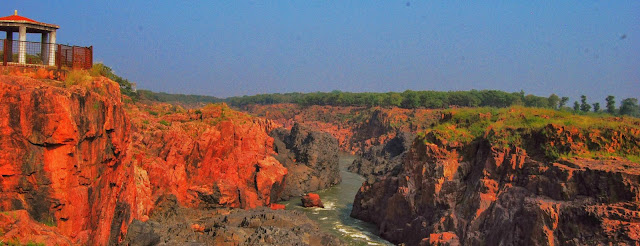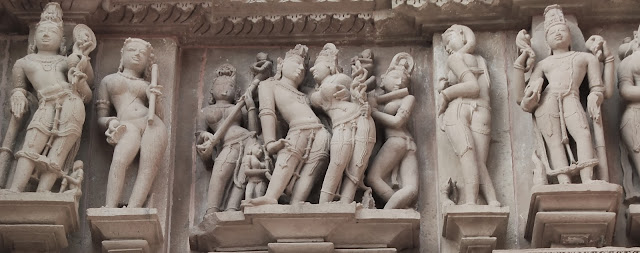The first thing that struck me when I visited the
temples of Khajuraho was how much has our culture changed in past 1000 years. When
I use the word change here I don’t really mean in positive sense. If I asked
any of my female friends how safe they felt expressing their sexuality or even
just being relaxed amongst people the answer would probably be – not much. Sexual
interaction can be both beautiful and ugly, depending on who and how it’s being
looked at. It can be refreshing and devastating depending on how one experiences
it. In today’s culture females get subjected to a lot of negative sexual energy
but 1000 years back our culture seemed to have a very different outlook.
 Both me and my old school mate had not taken a break for
some time. The first opportunity we got to go on quick getaway, we lapped it.
Khajuraho wasn't part of initial plan but after
contemplating few other options we thought it might not be so bad. So we hopped
on to the evening train from Delhi to reach Khajuraho next morning. We both were
travelling together in train after long so it was certainly more fun and some
where reminded us of our early days when we use to have enough time and less
money. Train reached Khajuraho around 7.30am.
Both me and my old school mate had not taken a break for
some time. The first opportunity we got to go on quick getaway, we lapped it.
Khajuraho wasn't part of initial plan but after
contemplating few other options we thought it might not be so bad. So we hopped
on to the evening train from Delhi to reach Khajuraho next morning. We both were
travelling together in train after long so it was certainly more fun and some
where reminded us of our early days when we use to have enough time and less
money. Train reached Khajuraho around 7.30am.  |
| Sunrise from train compartment |
 We had decided that this will be a no frills trip. Therefore preferred mode of conveyance for full day sightseeing was an auto-rickshaw (tuk-tuk as its called in many other countries). Our first stop was Raneh falls, its around 20 kms from Khajuraho, took us around 30 mins but on the way we smelled some fresh Jalebi and Samosa. We couldn't resist it so stopped to enjoy the breakfast. I can eat sweet any time, any where and what better than Jalebi.
We had decided that this will be a no frills trip. Therefore preferred mode of conveyance for full day sightseeing was an auto-rickshaw (tuk-tuk as its called in many other countries). Our first stop was Raneh falls, its around 20 kms from Khajuraho, took us around 30 mins but on the way we smelled some fresh Jalebi and Samosa. We couldn't resist it so stopped to enjoy the breakfast. I can eat sweet any time, any where and what better than Jalebi.  |
| 100 mt drop of Ken river forming Raneh falls |
Raneh falls is nothing like another water fall I had seen earlier. 100 ft drop of Ken river into crystalline granite canyon is an amazing view. Incidentally the water level keeps fluctuating, since we were visiting right after monsoon, fall level was good. After multiple point of fall the river continues in this multi-colour granite canyon for another 5 kms. I'm sure this would look even more wild during heavy monsoon period.
 |
| Ken river runs through multi-color crystalline granite mountain for 5kms |
 |
| Heart shaped plunge pool at Pandev falls is said to have emerged from ground by impact of Bheem's mace |
 |
| Gleaming waiters at the dhaba |
After Raneh falls next was Pandav's fall. This is a beautiful plunge pool hidden between mountain ranges. Vindhya mountain range is one of oldest mountain ranges which separates North and South India. Vindhyas and Satpura range is what makes the state of Madhya Pradhesh (centeral province) so nice and green. Both these falls are part of Pannah Tiger Reserve. But our main agenda was not to see these waters bodies so we wrapped up quickly and headed on bumpy ride back to Khajuraho. Chicken curry and fish fry at the dhaba on the way was our driver's recommendation for lunch.
 |
| Lunch stop |
We reached Khajuraho and started our temple tour. As per the notes of Ibn Batuta there were 85 temples spread across this small town. Divided into four groups there are 22 temples still remaining in Khajuraho. Built by Chandellas between 950 and 1050 these temples was discovered during British raj and ever since then it has become of the world's famous tourist spot.
First temple we visited was part of southeastern group. Most interesting temple here is Chaturbhuj temple. Unlike all other temples, this is the only temple which has its entrance towards sunset (west). The 2.75 mt high statue inside is one of its kind too. It has legs of lord Krishna, Torso of Vishnu holding lotus, mace, shankh (Conch Shell which is blown to make horn like sound, typically used to make announcements) and chakra (spinning disc like weapon with 108 serrated edges) in his hand and head is that of lord Shiva.
 |
| Local priest explaining the three parts of statue - a combination Krishna, Vishnu and Mahesh |
External walls of the temple has some fascinating sculptures of beautiful woman and other gods and goddess. Most noticeable are Narsimha and Ardh-Nareshwar statues. Ardh-Nareshwar symbolizes half male-half female stereotype of lord Shiva.
 |
| Narsimha statue on external wall of Chaturbhuj Temple |
 |
| Ardh-Nareshwar is another stereotype of lord Shiva |
From Chaturbhuj we moved to another temple called Dulhedao Temple (bridegroom lord) which shows another stage of life of Lord Shiv as bridegroom. Nice green lawns and quiet surroundings of this temple was good place to just relax for a while.
 |
| Dulhedeo Temple |
 |
From there we moved on to Jain temple complex and then to Eastern Group of Temples. Its not that these temples were any less beautiful but by now we were feeling a little tired. So we decided to check-in a hotel and explore the largest complex, Western temple complex, after a break. We checked-in hotel Casa-De-William, at Rs.550 per night for twin room. Proximity to the Western temple complex made it a perfect choice.
 |
| Western temple complex |
After quick nap we stepped out again to visit the western complex. This is a huge complex with multiple temples inside for which you need to buy a ticket at the entrance. You can choose to take audio tour or even better is tour guides who are pleasant and will show you around.
 |
| Ganesh is integral part of most of the Hindu temples typically placed near the entrance of temple |
 |
| Main structure of the temple, the area of Garbh Griha and Shikhar representing mount kailash on top of it |
The stone monoliths were put together by precise interlocking joints, which is the reason why even after several centuries these temples remain as is. Some of these huge interlocked megaliths weighed as much as 20 tons.
 |
| One can see the unique interlocking of monoliths in these stones as some of the interlocked stones are removed or broken in this case |
 |
| The only source of light for this statue of Parvati inside Garb Grih is Sun light. The architecture of temple is such that light falls only on the statue and no where else |
 |
| Fine sculpture work can be seen all across the temples |
 Coming on to various sculptures on the outer wall of these temples. These sculpture were made to resolve certain socio-cultural issues that existed back then. Men use to follow the four stages (ashrams) of life very diligently. The first stage was Brahmacharya Ashram (childhood) which was meant for learning, after this was Grihasth Ashram (household life). One of the reasons for such evocative sculptures on temples was that people's inclination towards Grihasth Ashram was reducing. Which meant less inclination towards sexual activity, which meant less procreation. I can't fathom that this part of the world had problem of de-growing population! These sculptures were supposed to entice them into sexual activity and therefore procreate.
Coming on to various sculptures on the outer wall of these temples. These sculpture were made to resolve certain socio-cultural issues that existed back then. Men use to follow the four stages (ashrams) of life very diligently. The first stage was Brahmacharya Ashram (childhood) which was meant for learning, after this was Grihasth Ashram (household life). One of the reasons for such evocative sculptures on temples was that people's inclination towards Grihasth Ashram was reducing. Which meant less inclination towards sexual activity, which meant less procreation. I can't fathom that this part of the world had problem of de-growing population! These sculptures were supposed to entice them into sexual activity and therefore procreate.
During time of Chandelas there was heavy influence of Tantric culture on society. According to Tantric school of thought male
and female must come together in the right manner to produce positive energy. They believed that the only of way existence was coexistence and cooperation amongst each other was a must. Since religious places were most respected, therefore what better place to educate people about Tantric practices and sexual activities.
and female must come together in the right manner to produce positive energy. They believed that the only of way existence was coexistence and cooperation amongst each other was a must. Since religious places were most respected, therefore what better place to educate people about Tantric practices and sexual activities.
Another interesting thing to note is that these sculptures are on external wall of temple which again links it back to four ashrams. Only after going through Grihasth ashram one can enter Vanyaprasth (retired life) and Sanyas (renounced life). So you before you enter the temple and dedicate yourself to god for good, you must go through Grihasth Ashram stage.
As we started looking at individual sculptures closely we started noticing the huge amount of detailing and labor which had gone into making these sculptures. Sculpture of each human body, especially female had a beautiful flow to it which brought it almost alive. For example the fall of jewelry and clothes on the body shows the movement of body. If female body is being pulled by male counterpart towards him then jewelry would swing the other way showing reflex movement, whereas if she is leaning then jewelry would fall in the direction of her body movement.
There are some really interesting sculptures that i would like to highlight here. Sculpture of a woman holding a pen and paper clearly indicates that woman were literate back then.
 |
| Notice the flow of clothes and jewelry on human body and postures which make these sculptures come alive |
There are some really interesting sculptures that i would like to highlight here. Sculpture of a woman holding a pen and paper clearly indicates that woman were literate back then.
Girl holding convex mirror to adjust her make-up shows we were technically advance too.
The provocative dressing clearly shows how open was our society and how free woman felt with their sexuality.
Above sculpture shows a woman admiring nail marks on her body that says volumes about exciting moments she had spent with her male counterpart.
Above sculpture shows a woman admiring nail marks on her body that says volumes about exciting moments she had spent with her male counterpart.
There are various other sculptures which might seem meaningless at first glance but only until you have a closer look. Sculpture of a man-woman making love while a man on the side watching them and masturbating and the same time. Man and woman here are students and the the man watching is Tantric who is teaching them how to do it right. In the same statue we notice the man pressing woman's body at a particular place on her back which would help release positive energy.
In a lot of sculptures we saw a monkey as part of the scene. We were told that this monkey represents the naughty side of our mind. For example there is a sculpture in which a man is holding a woman but at the same time he is trying to whip away a monkey. The monkey here is naughty side of man's mind which is urging him to get sexually involved with the woman but man is trying oppose this naughty mind monkey.
Two states of mind has also been represented in a particular sculpture that one can see on various temples. It shows a dragon, thats right, a dragon with two humans interacting with it. One holding its tail which shows control of mind and other on dragon's back which shows the playful mood. Dragon and these two sides of mind reminded me of yin-yang hinting at some connection with Chinese mythology.
There is a series which also represents ignorant people. This has been shown in form of elephant. All elephants are looking straight except one elephant who is smiling as he looks at a couple making love. The male in couple is again putting pressure at particular point on woman's back to help release positive energy through right sexual activity. But ofcourse, ignorant elephant doesn't understand the complexity of this process and therefore smiles at them.
 |
| No, the man here is not standing on his head. Check the fall of his jewelry, its straight which shows he is lying down horizontally and not vertically |
Some of the other interesting sculptures represent various sexual postures. There is a particular sculpture which shows a man lying down with a woman on top facing away from him and at the same time he is also releasing postive energy from genitals of two other females on either sides. Not sure if this was yet another Tanric teaching his disciple or having multiple sex partners was the thing to do back then.
There are postures which show oral sex which is now also called 69.
There is even a representation of a man being treated to get his erection back, another form of Viagra I guess.
Another interesting sculpture shows three different stages of love making. At first glance all three sculptures look the same but as you take a closer look you realize that these are three different stages in love making. In first sculpture both man and woman are standing on one leg each and other leg is wrapped around each other's body. This represents the initial stage. Second sculpture show woman's back bent-in indicating how deeply she is involved. This sculpture also shows intensity on face of both man and woman. In the third and the top most sculpture one can see a more relaxed state. Needless to show that these sculptures are influenced by Vatsyayan's Kamasutra but some historians think otherwise.
Sexual interaction between a male warrior and horse or a dog and female are shown to indicate whats not right and how one shouldn't loose sanity.
Besides sexually provocative sculptures there are are other spiritual and secular sculptures as well on the walls of temples.
There are sculptures which show other rituals of life like marriage.
There are sculptures which show other rituals of life like marriage.
We didn't realize how entire day was gone gazing these amazing sculptures. We weren't finding these sexual provocative sculptures amusing anymore as we had developed a new meaning to it.
We decided to end the day with light and sound show which didn't turn out very exciting. By 9 - 9.30 pm city was almost dead and we decided to call it a day today.
Next morning we started our cab ride to the rustic city of Orcha. Throughout the four hour drive we kept on discussing how and what could have led to such a drastic change in our society, a drastic change in outlook towards woman? What went wrong in last 1000 year ? Did the Moghuls and other rulers brought in their culture and policies which curbed woman and made them weaker? Was free sexual desires and sexual activity made a almost a taboo? Or was it just another way of controlling and making it more civilized way of living in someone's opinion? These discussions and debates are endless but our weekend wasn't. Sunday was over soon and we were back to modern city life.
Next morning we started our cab ride to the rustic city of Orcha. Throughout the four hour drive we kept on discussing how and what could have led to such a drastic change in our society, a drastic change in outlook towards woman? What went wrong in last 1000 year ? Did the Moghuls and other rulers brought in their culture and policies which curbed woman and made them weaker? Was free sexual desires and sexual activity made a almost a taboo? Or was it just another way of controlling and making it more civilized way of living in someone's opinion? These discussions and debates are endless but our weekend wasn't. Sunday was over soon and we were back to modern city life.


































+At+Doi+Inthanon+sumit.JPG)












+one+of+several+temples+in+Mae+Hong+Son.JPG)








